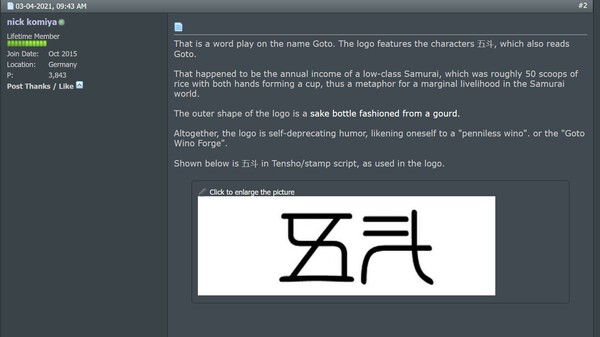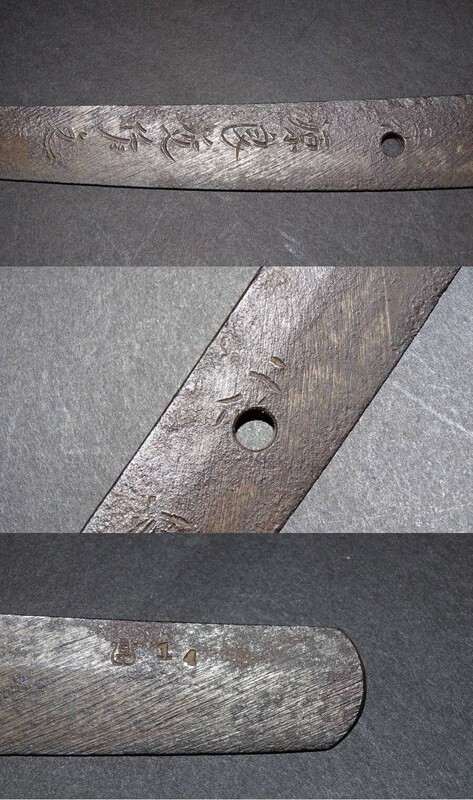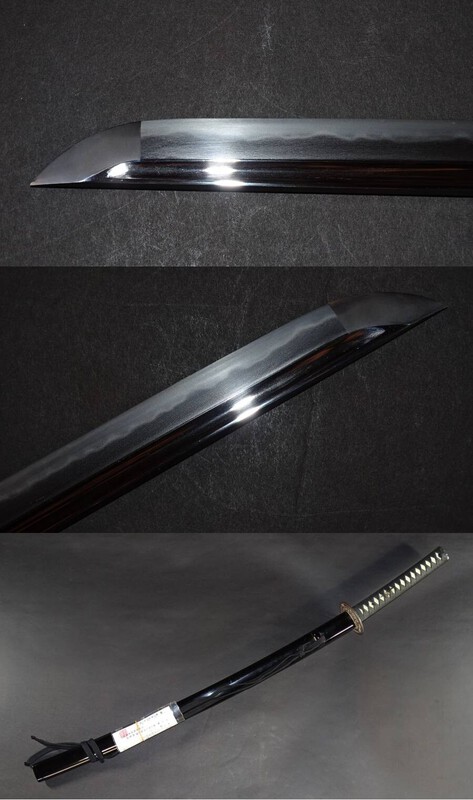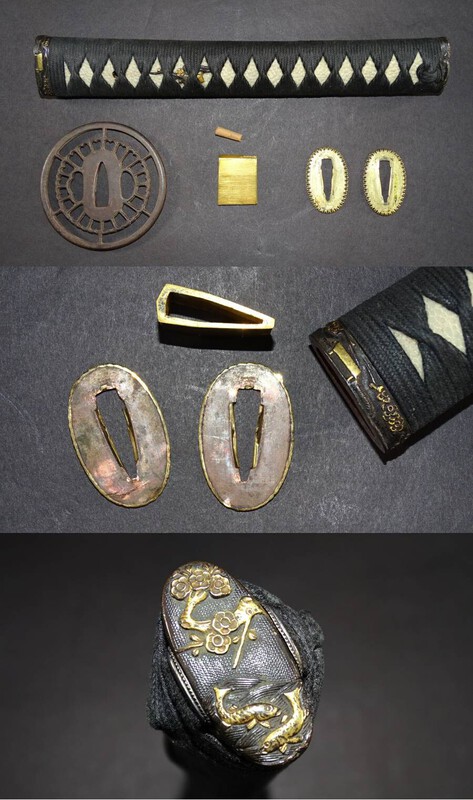-
Posts
10,914 -
Joined
-
Last visited
-
Days Won
128
Content Type
Profiles
Forums
Events
Store
Downloads
Gallery
Everything posted by Bruce Pennington
-

I Tried! Help Please!
Bruce Pennington replied to Bruce Pennington's topic in Translation Assistance
Excellent, thanks Ray! Not my gunto, but one I'm adding to the Stamps Survey. Much appreciated! -
Showa stamped mei. Didn't see anything I recognized in the JapaneseSwordIndex of smiths. Thanks guys!
-

Light weight/Dress Shingunto
Bruce Pennington replied to ribendao's topic in Military Swords of Japan
You may be right. I cannot find where I had read that, so it's possible I've blended the discussions in my memory. Edit/Update: I did blend the memory. I found the statement I had read from a World Renowned Gunto expert, right here on our own NMB!: https://www.militaria.co.za/nmb/topic/23234-chromed-and-fullered-type-98/?do=findComment&comment=235536 and like you said, he was discussing the Type 95. -

Light weight/Dress Shingunto
Bruce Pennington replied to ribendao's topic in Military Swords of Japan
I'm wondering if it's chromed. I have one that's chromed. They experimented with chrome for a little bit, trying to avoid rust, but found the steel still suffered from rust anyway, so it was dropped. -

Type 95 NCO Sword for comments
Bruce Pennington replied to Kaiser21's topic in Military Swords of Japan
And this one is by the same contractor! Look at the screw and nut. It is the standard kind. -

Type 95 NCO sword date help?
Bruce Pennington replied to nchistory's topic in Military Swords of Japan
Welcome Chris! I may have been wrong about that screw, after seeing the nut-side. The black color just does not look right to me. But, the Aussie’s will be waking up in a few hours and @Shamsy and @Stegel should be able to clear that up for you. There are a couple of other guys that collect Type 95s that may have a better idea, too. -

translation help please shin gunto type 3 1944
Bruce Pennington replied to Alex1984's topic in Translation Assistance
-

translation help please shin gunto type 3 1944
Bruce Pennington replied to Alex1984's topic in Translation Assistance
The Gifu stamp was a military inspection stamp on blades made in non-traditional manner, which was true for most WWII blades. -
I didn't realize the Tenshozan stamp was a military inspector. I had always assumed it was a shop stamp, but it makes sense that it would be a military inspector. It spans the full spectrum across the years of civil stamps and military ones. I wonder if it began as a private shop stamp and was adopted by the military after 1942. My count is similar to yours (I've added it to the one above): Stamp 1935 1938 1939 1940 1941 1942 1943 1944 1945 No Date Tenzoshan Anchor 1 1 4 4 5
-

Toei Ju Ota Chickahide
Bruce Pennington replied to CrazyforYou's topic in General Nihonto Related Discussion
-

SNLF gunto on Hainan Island 1941
Bruce Pennington replied to MarcoUdin's topic in Military Swords of Japan
You can see some more pictures of similar wrap here: Gunto at War. -
Civil Stamps Stamp 1935 1938 1939 1940 1941 1942 1943 1944 1945 No Date Showa 1 1 3 13 9 1 1 106 Seki 1 1 6 2 58 Gifu Total 1 G/s 7 5 G/s 15 2 G/s 3 G/s – Gifu and small Seki stamps Arsenal Stamps To & Ko 6 on Kyu and Zoheito Seki, small 5 3 Na 2 23 3 1 Saka 1 5 8 Nan 1 Toyokawa Anchor 1 16 Tenzoshan Anchor 1 1 4 4 5
-
I've re-arranged my stamp survey chart, and you can see that the "NA" stamp initially replaced the large Seki in 1943. They then went to the Gifu in 1944 and '45. STAMP SURVEY Stamp 1935 1938 1939 1940 1941 1942 1943 1944 1945 No Date Showa 1 1 3 13 9 1 1 106 Seki 2 7 33 9 9 5 83 Na 2 23 3 1 Gifu Total 2 14 22 2
-
An update on the "5 measures" hotstamp identified by Richard Fuller, who said of the stamp: "(vii) ‘Five measures’ stamp. Literally Go (5)-To (measure of capacity. (1 To = 3.97 Imperial gallons). Significance unknown. Very rare." I ran into it going through the Cillo edition of Slough on a blade by Ogawa Tofuji 小川 外藤 . Knowing that some hotstamps can contain a kanji of the smith's name, I thought I'd run the item by @mecox and his lovely bride for an opinion. Mal's amazing research skills came through and uncovered the fact that Tofuji was a smith at the Goto Kaji-jo (Goto Sword Forging Centre) in Seki! Mal also pointed out that the stamp is in the shape of the old gourd sake bottles and the 2 kanji closely resemble a couple of sake volume terms: 1 gou 合 = 180 mL (0.1804 L) (a standard serve of sake) 1 shou 升 = 1804 mL (1.804 L) (1 shou = 10 gou) 1 to 斗 = 18040 mL (18.04 L) (1 to = 10 shou = 100 gou) He wondered if the image is a play on words between the Shop name and sake references. I then ran the whole discussion by Nick Komiya HERE at Warrelics, who agreed with Mal and added: Mal is looking for blades by Tofuji's teacher, who also worked at the shop, Koketsu Kanekami 纐纈 兼上, to see if he also used the stamp, but so far it seems that only Tofuji blades have the mark. It is quite possible that the stamp is a craftily made play on all the above, playing the shop name into a statement that he's getting paid like a low-class Samurai with 5 measures of sake! Quite brilliant! Mal has a brief article on the topic, that I've jumped the gun in quoting from. All of this info comes from his work and Nick's insight. Many thanks to both of them! I don't know how I'll amend this item in the Stamps Document. It practically will need a page of it's own!
-
Yes, I see where you're going. So, my sample size is too small to really chase down your idea. But here is what I have, and it sort of confirms it: Of the dated blades above, only 1 - Nobumitsu, with a small seki - had a blade later with a Gifu stamp Aug 1944 Nobumitsu small Seki on nakago, Gifu in sakura on mune Out of 15 Gifu-stamped blades on file, 5 smiths had matching blades in the Seki-stamped list: 1944, Jun Norinaga Gifu - No Date Large Seki 1944, Aug Nobumitsu Gifu on mune -- small Seki 1945, Jan Katsumasa Gifu - No Date Large Seki 1945, Feb Masahiro Gifu - No Date Large Seki 1945, Feb Kanemune Gifu - No Date Large Seki Considering what we observed earlier, the Large Seki stamped blades were likely made no later than 1943. Like I said, it's a tiny sample, but it fits your idea.
-

Mauser C96 With SMR Railway Stamp?
Bruce Pennington replied to Bruce Pennington's topic in Tanegashima / Teppo / Hinawajū
You nailed it Trystan! -
It will take me a while to go through my Seki files. I have 19 dated blades and 50 with no date. So far I've completed a look at the dated ones: Seki 1941Jan Kanemichi Slough Large Seki 1942 Kanemichi Large Seki 1942 Kanemichi NGFcollection Large Seki 1942 Kiyonobu (unknown) Seki 1942 Masayuki Gunzuko Large Seki 1942 Toshimasa Large Seki 1942 Yoshishige Fuller Large Seki 1943 Tadayuki Large Seki 1943 Yoshishige Star Pennington Large Seki 1944 Aug Kanehide Star RSnihontocraft Small Seki 1944 KanehisaSeSe Fuller Large & Small Seki 1944 May Kunitoshi Star Slough Small Seki 1944 May Kunitoshi Star Slough Small Seki 1944 Oct Nobumitsu RS Small Seki 1944 Sep Nobumitsu JamesrNMB Small Seki 1945 Kanenori Na (unknown) Seki 1945 Kaneyoshi Fuller Small Seki 1945 Katsunori (unknown) Seki 1945 Yoshitada Small So far, Looks like the Large Seki ran through 1943 and the small Seki ran in '44 and '45. When I get a chance, I'll look over the undated blades to see if anything stands out. Update: Went through the first 20 of 50 undated, and all are Large Seki, so far.
-
How interesting! I didn’t know that was a practice, to indicate that they are second generation. But that would certainly clear up any confusion if both father and son were making swords at the same time and using the same name.
-
Another potential one, though munei and no stamps
-

What is this?
Bruce Pennington replied to TheGermanBastard's topic in Auctions and Online Sales or Sellers
Possibly a Murata-to? Posting some pics before the site goes extinct: -

Type 95 Copper NCO at Auction
Bruce Pennington replied to Infinite_Wisdumb's topic in Auctions and Online Sales or Sellers
Ha! And I'm no Stephen!!! .... but yes, legit. @Shamsy or @Stegel are the experts on these, though. Interesting one in that the Kokura stamp and Suya stamp are switched from their normal positions. I have heard that this happened occasionally. I see also, one of those green handled Chinese Type 32s for sale too, @BANGBANGSAN! -

MOSLE collection article
Bruce Pennington replied to BIG's topic in General Nihonto Related Discussion
Wow, over 2,200 swords. Hard to comprehend.- 1 reply
-
- 2
-

-
Thomas, John @PNSSHOGUN just found a beauty that I think might be a zoheito. Uniquely has the Suya Shoten stamp on the nakago by the number "14" Is this Yoshichika? And what is the single kanji at the top of the mei, cut by the ana? Update: After talking it over with John, the Suya stamp likely indicates this blade had been previously fitted by the Suya Shoten Co. and the blade is likely traditionally made. found HERE.
-
















